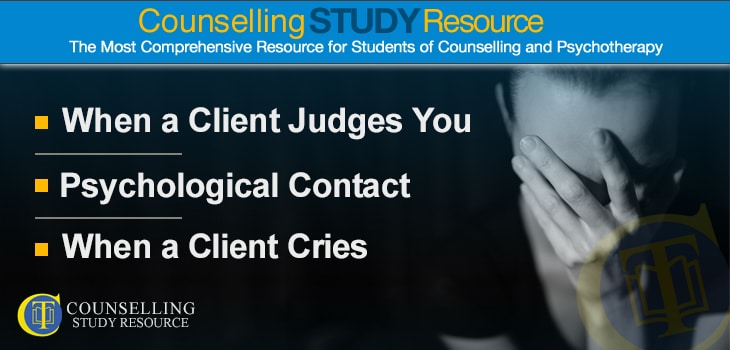035 – When a Client Judges You – Psychological Contact – When a Client Cries
In episode 35 of the Counselling Tutor Podcast, Rory Lees-Oakes and Ken Kelly discuss how to deal with clients who show prejudice towards you. ‘Theory with Rory’ explains the ‘hidden condition’ of psychological contact. Last, the presenters talk about what to do when a client cries in the therapy room.
When a Client Judges You (starts at 4.20 mins)
As student counsellors, we learn about equality and diversity, with the aim of being able to show all clients unconditional positive regard (UPR). But what if a client appears to show a prejudice towards us on the grounds of variables that have nothing to do with our counselling ability, e.g. gender, clothing, age or weight? There is no easy answer here, nor any one answer that would be appropriate in every situation, but Ken and Rory offer a number of general tips:
- Remember that this is the client’s ‘stuff’, not yours. If you are sure of this in yourself – i.e. you feel secure and confident as a counsellor – then a client holding a view that you cannot counsel them because you are (for example) ‘too young’ will not feel hurtful to you.
- Try reflecting the view back to the client, as an interesting lens on their process, exploring where their concern is coming from. For example, if it has arisen from a lack of understanding on the part of the client of what counselling is and how it works, you could re-explain this. Or if it stems from something in their past experience, you could support them in looking at it.
- If the remark did feel hurtful to you, take this to your personal-development group and/or your supervisor, so you can explore what it is within yourself that has led to you reacting to it in this way.
Finally, if an organisation seems to be judging you on something that doesn’t relate to your ability as a counsellor, remember that they must abide by the Equality Act 2010.
Psychological Contact (starts at 18.08 mins)
Rory examines the first of the hidden conditions of Carl Rogers. The three core conditions – congruence, UPR and empathy – are relatively well-known, though Rogers never actually used the term ‘core conditions’. But in fact Rogers held that six conditions are necessary and sufficient to bring about constructive personality change. He described these in a paper, ‘The Necessary and Sufficient Conditions of Therapeutic Personality Change’, published by the Journal of Consulting Psychology in the 1950s.
The first of the six conditions is that the counsellor makes psychological contact with the client (i.e., they are ‘on the same page’ psychologically). Rory explores the possible barriers to this, which include:
- the client not understanding where they are and what they have come for – e.g. being under the influence of drugs or alcohol
- the client and counsellor being unable to understand each other’s language
- the client looking not for counselling but for something else, e.g. friendship or expert advice (perhaps medical or legal)
- there being a mismatch in the communication styles of the client and counsellor (for example, if one uses a lot of metaphor but the other finds this difficult)
- the client having a mental-health condition (e.g. schizophrenia or memory loss) that means they do not share the reality of others). Although this may be a barrier, Rogers objected to the pathologising of such conditions (which relies on the medical model) and asserted that person-centred counselling could still be helpful. Even if it is not, other forms of talking therapy may be of value, for example validation therapy for people with dementia.
When a Client Cries (starts at 24.32 mins)
It is natural that clients will sometimes cry in the therapy room, as this is a place where we encourage emotion to be experienced and talked about, but how is the right way for the counsellor to respond? Positive emotions are much more highly valued – and so accepted – in our culture, meaning that it can be difficult to cry in front of others.
Ken and Rory give some tips, based on their counselling experience:
- Do have tissues available in the room, within arm’s reach of the client (as not doing so might make it look as if crying is not welcome there).
- If a client starts to cry, don’t automatically pass them the tissues or even mention that they are there: doing so can interrupt the flow of the client’s process, plus it is the client’s choice whether they wish to use them (some may choose to let the tears stream down).
- When a client cries, you could say: ‘You’re not on your own.’
- If a client apologises for crying, you could say: ‘All of your emotions are welcome here.’
- Don’t say, ‘It’ll be alright’ (trying to rescue the client) or ‘Don’t cry!’ (which is generally more about the issues of the person who says it than about the issues of the person crying).
- Remember that if a client is crying, it probably suggests they feel safe with and trusting of you and the environment. This brings the opportunity to do deep and beneficial work.


